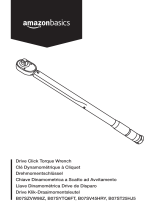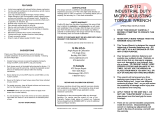Page is loading ...

®
Model
TRQ-21101
STORE THIS MANUAL IN A SAFE
PLACE FOR FUTURE REFERENCE
888-648-3371
NEED HELP?
!
?
TORQUE WRENCH
OPERATOR’S MANUAL
• At low torque settings, pull wrench slowly to observe click.
Please read and understand entire manual, including all safety information, before using torque
wrench. This tool is a precision measuring instrument. Handle with care and store properly. Do
not attempt to increase leverage of this wrench with any other device. Failure to follow all
instructions could result in damage to torque wrench, property damage, or injury.
• Wrench is shipped ready to use, calibrated and tested to an accuracy of +/- 4% in CLOCKWISE
direction and +/- 6% in COUNTERCLOCKWISE direction. To maintain this accuracy, it is
important that wrench is stored with torque scale at lowest setting, 10 in.-lb (1.1 Nm). This
setting relieves extra tension on the internal spring, eliminating fatigue that can adversely affect
accuracy.

SETTING TORQUE READING
This is a dual-range torque wrench marked with
inch pounds (in.-lb.) and Newton meters (
Nm
)
on opposite sides of handle. Wrench measures
torque in clockwise and counterclockwise
directions.
The torque scale is marked on the handle body
with more precise subdivisions on the knurled
handle (Fig. A). In these instructions the handle
body scale will be referred to as the “main
scale” and the knurled handle scale will be
referred to as the “micrometer scale”. The
micrometer scale has two rows, top row for
in.-lb. and bottom row for Nm.
Inch Pounds (Example reading: 105 in.-lb.)
1. COARSE SCALE ADJUSTMENT (Fig. B):
Depress and hold the collar down while
turning the knurled handle until its top edge
is even with the horizontal “100” mark on
the main scale and the ”0” mark on the
micrometer scale is centered on the vertical line of the main scale.
2. FINE SCALE ADJUSTMENT (Fig. C):
The micrometer scale’s top row divides the main scale markings into 10 divisions.
Every micrometer scale marking equals 1 in.-lb., also known as the minimum increment. To increase torque from
100 to 105, turn micrometer handle clockwise until the “5” mark of the top row is centered on the vertical line of
the main scale. 100 in.-lb. (main scale) + 5 in.-lb. (micrometer scale) = 105 in.-lb.
3
. Release collar to lock torque setting. Wrench is now set to measure
105
in.-lb. of torque and ready to use.
Newton Meters (Example reading: 11 Nm)
Setting desired torque on the Nm scale uses the same procedure described above for in.-lb. The micrometer scale’s
bottom row divides the main scale markings into 10 divisions. Every marking equals 0.113 Nm, also known as
the minimum increment.
To set a torque value of 11 Nm, turn knurled micrometer handle until top is aligned with “10.1” on main scale and the
“0”mark on the bottom row of the micrometer scale is centered on vertical line of main scale. To increase torque from
10.1 to 11, turn micrometer handle clockwise until the 0.90 mark is centered on vertical line of main scale. 10.1 Nm (main
scale) + 0.90 Nm (micrometer scale) = 11 Nm. Wrench is now set to measure
11 Nm
of torque and ready to use.
WRENCH OPERATION
Fig. D illustrates the basic operation of the torque wrench. For accurate operation, grasp the knurled handle only and apply
pulling force. When the desired torque setting is reached, the roller bearing and roller pin will roll over each other, causing a
click you can hear and feel. NOTE: At low torque settings, click can be subtle. Use wrench in a quiet environment.
1. Install proper socket/attachment to square drive. Place socket on nut/bolt to be tightened.
2. Operate torque wrench the same as a standard socket wrench to tighten nut/bolt. As nut/bolt becomes snug, slow
operation to a smooth, steady pull. Operating wrench too quickly or with too much force may cause you to miss the
exact torque setting. At the instant the wrench clicks, torque setting has been reached. Stop pulling wrench and
release pressure on handle. Do not continue to pull aer torque setting is reached. Doing so will overtighten the
nut/bolt and could damage wrench. Once pressure is released from the handle, wrench will automatically reset for
next operation. NOTE: At low torque settings, use extra care to release wrench at the proper point aer it clicks.
3. Wrench does not measure torque below 10 in.-lb./1.1 Nm.
4. Do not use wrench to break free stuck fasteners.
MICROMETER SCALE
HANDLE BODY
MAIN SCALE
KNURLED HANDLE
LOCKING COLLAR
Fig. A
Fig. D
WRENCH ROTATION
Torque is measured in
both CLOCKWISE and
COUNTERCLOCKWISE directions.
HANDLE
PIVOT
POINT
"CLICK"
Fig. C
10
30
50
70
90
110
130
150
20
40
60
80
100
120
140
IN.-LB.
STORE AT
10 IN.-LB.
0
Nm
4
1.02
0.11
56
10
30
50
70
90
110
130
150
20
40
60
80
100
120
140
IN.-LB.
STORE AT
10 IN.-LB.
0
IN.-LB.
0.56
1
0.68
0.45
9
Fig. B
Top row
Bottom
row
Depress collar
and turn
VIEW TOP ROW OF MICROMETER SCALE
VIEW BOTTOM ROW OF MICROMETER SCALE

MAINTENANCE AND STORAGE
1. If wrench has not been used for a long period of time, operate it several times at
a low torque setting. This will allow internal lubricant to recoat moving parts.
2. When wrench is not in use, keep adjustment at lowest torque setting,
10 in.-lb./1.1 Nm.
(Fig. E).
Do not turn handle below lowest torque setting.
3. This wrench is a precision measuring instrument. Take care to operate wrench
correctly. Store in a clean, dry environment.
4. Clean wrench by wiping with a clean, dry, lint-free cloth. Do not immerse in any
type of liquid or cleaner. This may damage the internal components of the wrench.
Fig. E
10
30
50
70
90
110
130
150
20
40
60
80
100
120
140
IN.-LB.
STORE AT
10 IN.-LB.
0
IN.-LB.
0.56
1
0.68
0.45
9
0.42
0.83
1.25
1.67
2.08
2.50
2.92
3.33
3.75
4.17
4.58
5.00
5.42
5.83
6.25
6.67
7.08
7.50
7.91
8.33
8.75
9.17
9.58
10.00
10.42
10.83
11.25
11.67
12.08
12.50
12.91
13.33
13.75
14.17
14.58
0.56
1.13
1.69
2.26
2.82
3.39
3.95
4.52
5.08
5.65
6.21
6.78
7.34
7.91
8.47
9.03
9.60
10.16
10.73
11.29
11.86
12.42
12.99
13.55
14.12
14.68
15.25
15.81
16.38
16.94
17.51
18.07
18.64
19.20
19.77
5
10
15
20
25
30
35
40
45
50
55
60
65
70
75
80
85
90
95
100
105
110
115
120
125
130
135
140
145
150
155
160
165
170
175
TORQUE UNIT CONVERSION TABLE
CONVERSIONS
1 .-lb. =
0.138 m-kg
12.0 in.-lb.
1.355 Nm
13.82 cm-kg
1 Nm =
0.7375 .-lb.
8.8507 in.-lb.
0.1019 m-kg
10.19 cm-kg
1 in.-lb. =
0.0833 .-lb.
0.1129 Nm
0.0115 m-kg
1.1521 cm-kg
INCH
POUNDS
(in.-lb.)
FOOT
POUNDS
(.-lb.)
NEWTON
METERS
(Nm)
INCH
POUNDS
(in.-lb.)
NEWTON
METERS
(Nm)
FOOT
POUNDS
(.-lb.)
INCH
POUNDS
(in.-lb.)
NEWTON
METERS
(Nm)
FOOT
POUNDS
(.-lb.)
1
2
3
4
5
6
7
8
9
10
11
12
13
14
15
16
17
18
19
20
1.35
2.71
4.06
5.42
6.78
8.13
9.49
10.84
12.20
13.55
14.91
16.27
17.62
18.98
20.33
21.69
23.04
24.40
25.76
27.11
12
24
36
48
60
72
84
96
108
120
132
144
156
168
180
192
204
216
228
240
1
2
3
4
5
6
7
8
9
10
11
12
13
14
15
16
17
18
19
20
8.85
17.70
26.55
35.40
44.25
53.10
61.95
70.80
79.65
88.50
97.35
106.20
115.06
123.91
132.76
141.61
150.46
159.31
168.16
177.01
0.73
1.47
2.21
2.95
3.68
4.42
5.16
5.90
6.63
7.37
8.11
8.85
9.58
10.32
11.06
11.80
12.53
13.27
14.01
14.75

NOTE: Exploded view diagram provided for illustration purposes only. Do not
disassemble any part of torque wrench. There are no user serviceable parts on
or inside wrench. Parts shown and assembly may differ slightly based on model.
RATCHET
FACE PLATE
RATCHET
GEAR/DRIVE
FACEPLATE
SCREWS
PIVOT
PIN
RUBBER
O-RING
RETAINING
RING
LOCKING SHAFT
ADJUSTMENT
COLLAR
SPRING
KNURLED
HANDLE
CAP
PIN
RATCHET PAWL
AND SPRING
RETAINING
RING
RATCHET
ARM
ROLLER
WASHER
ADJUSTMENT
SPRING
SPRING
CAP
ADJUSTMENT
SCREW
LOCK
NUTS
Drive 1/4 in.
Ratchet 72 Tooth
Length 8.8 in.
Dual Range 10-150 in.-lb. / 1.1-16.9 Nm
Increment 1 in.-lb. / 0.113 Nm
Accuracy Clockwise +/- 4%, Counterclockwise +/- 6%
© 2017
TEKTON.COM
3707 Roger B Chaffee SE
Grand Rapids, MI 49548
Made in Taiwan
/







